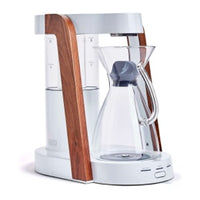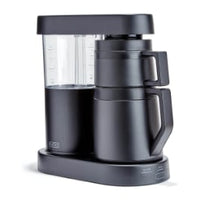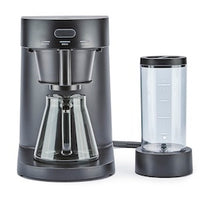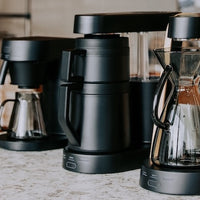Why Your Iced Coffee Never Tastes Like the Cafe Version
Key Takeaways
-
Café-style iced coffee benefits from precision brewing techniques not often used at home
-
Coffee strength, brewing method, and cooling process all impact flavor quality
-
Ice dilution is one of the biggest reasons home versions taste weaker
-
Milk and sweetener ratios are often different in cafés than at home
-
The right equipment, beans, and method can help you get café-quality iced coffee at home
There’s something about café iced coffee that just feels… better. It’s balanced, refreshing, and full of flavor from first sip to last. Yet when you try to make it at home, it often tastes thin, flat, or overly bitter. The truth is, cafés use specific methods and equipment to control every variable — something many home brewers overlook.
By understanding what makes a café iced coffee work so well, you can recreate that same magic in your kitchen.
The Café Advantage: Precision and Consistency
Professional cafés aren’t winging it. Every brew is measured, timed, and temperature-controlled. This level of precision ensures every iced coffee tastes exactly how the barista intends.
Common café advantages include:
-
Dialed-in grind size matched to the brew method
-
Water temperature control within a narrow range (often 200–205°F / 93–96°C)
-
Consistent brewing ratios measured by weight, not volume
-
Filtered water for optimal flavor clarity
At home, most iced coffee mishaps happen because one or more of these variables is inconsistent.
Strength Matters More Than You Think
One of the biggest differences between home and café iced coffee is strength. When you pour hot coffee over ice, you’re instantly diluting it. Cafés anticipate this and brew stronger coffee specifically for iced drinks.
Example ratios:
-
Hot coffee: 1:16 (coffee to water)
-
Iced coffee: 1:14 or even 1:12 for bolder flavor
If you brew at your usual strength and then add ice, your coffee will inevitably taste watered down.
The Cooling Factor: Avoiding Shock Dilution
When hot coffee meets ice, the immediate melting can rob you of flavor before your drink even cools. Professional cafés often use one of these strategies to minimize that:
-
Flash brewing over ice with a smaller hot water volume so ice melt is part of the total water ratio
-
Pre-chilling coffee in a refrigerator before serving over ice
-
Cold brewing for a naturally smooth and chilled base
At home, simply letting your coffee cool for 10–15 minutes before adding ice can significantly reduce dilution.
Brew Method Makes a Difference
Not all brewing methods produce equally great iced coffee. Cafés tend to use methods that highlight brightness and sweetness while maintaining body.
Best options for iced coffee:
-
Pour-over (flash brew): Maintains complexity while chilling rapidly
-
Cold brew: Smooth, low-acid, ideal for milk-based iced drinks
-
Espresso over ice: Strong base for iced lattes and americanos
If your home brew tastes flat, consider switching methods or experimenting with different grind sizes.
The Ice Itself Matters
Ice seems like an afterthought, but cafés pay attention to it for a reason. Large, clear cubes melt slower than cloudy, small ones, preserving flavor longer.
Home tips:
-
Use filtered water for making ice to avoid off-flavors
-
Opt for larger cubes or spheres to slow dilution
-
Keep your glass chilled before serving
Milk and Sweetener Ratios
Café iced coffee often tastes smoother because of the way milk and sweeteners are incorporated. Instead of just dumping cold milk into hot coffee, they:
-
Froth or aerate milk slightly for a creamier mouthfeel
-
Use simple syrup instead of granulated sugar for even mixing
-
Maintain a consistent coffee-to-milk ratio for balance
At home, making a batch of simple syrup and measuring milk can bring you closer to café results.
Bean Quality and Freshness
Even the best brewing technique can’t save stale or low-quality beans. Cafés rotate beans frequently and grind to order, ensuring maximum freshness.
At home:
-
Buy smaller quantities of fresh beans
-
Grind just before brewing
-
Store beans in an airtight container away from light and heat
Water Quality: The Silent Flavor Shaper
Cafés often use filtered water with specific mineral content to enhance coffee flavor. Tap water with high chlorine or mineral levels can make iced coffee taste off.
Consider using filtered water at home — the difference in clarity and flavor can be dramatic.
Practice Makes Perfect
Even with the right gear and beans, iced coffee takes practice. Adjusting grind, ratio, and cooling method based on your taste will help you fine-tune your process. Keep notes like cafés do — it’s how they achieve consistency.
The Ratio Coffee Advantage
A coffee machine from Ratio Coffee delivers the temperature stability and brewing consistency that’s essential for making great iced coffee at home. Paired with fresh beans, proper ratios, and smart cooling techniques, you can match the café experience without leaving your kitchen.
Bringing Café Flavor Home
The gap between café and home iced coffee isn’t about secret recipes — it’s about precision. Brew stronger, control temperature, manage dilution, and choose quality beans, and your home iced coffee can rival your favorite coffee shop’s version.
It may take a few tries to dial in, but once you find your formula, every glass can be as satisfying as the one you’d buy over the counter.
Frequently Asked Questions
Why does my iced coffee taste bitter?
Likely due to over-extraction or stale beans. Try a slightly coarser grind or fresher coffee.
Can I just use leftover hot coffee for iced coffee?
You can, but it will taste flat compared to brewing specifically for iced coffee.
Is cold brew better than iced coffee?
It depends on your taste. Cold brew is smoother and less acidic, while iced coffee can be brighter and more complex.
How do cafés keep iced coffee sweet without grainy sugar?
They use simple syrup, which dissolves easily in cold drinks.
Should I always brew iced coffee stronger?
Yes, to account for dilution from ice — even when using large cubes or pre-chilled coffee.
 Ratio Eight S2
Ratio Eight S2
 Ratio Eight Original
Ratio Eight Original
 Ratio Six
Ratio Six
 Ratio Four
Ratio Four
 Compare Machines
Compare Machines






